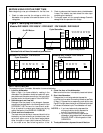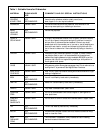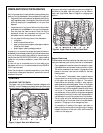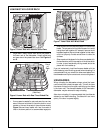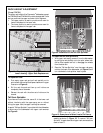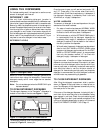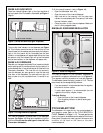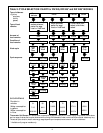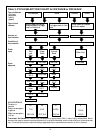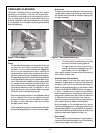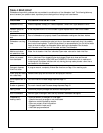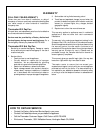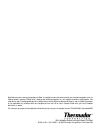
CARE AND CLEANING
Thermador
®
dishwashers have a three-stage filter system
comprised of
: a microfilter, a fine filter and a coarse filter.
The microfilter is self-cleaning, but the coarse filter and fine
filter will sometimes be found to have collected items, from
bones to toothpicks or seeds that have been left on the plates
or in the glasses. For this reason the following maintenance
should be observed:
• Wash arms
The wash arms should be checked for food particles on
a regular basis to assure that the spray orifices are clear
and unobstructed. If the wash arms require cleaning they
are easily removable:
Filters
• The filters should be checked on a weekly basis. To remove
the filters, turn the knurled ring handle of the coarse/
microfilter 1⁄4 turn counter-clockwise, see Figure 16,
and lift out the coarse/microfilter. After removing the
coarse/microfilter the fine filter can also be lifted out for
inspection. Examine the filters. If large solids, such as bones,
or large seed(s) are present, remove the filters and dispose
of the large solids by emptying into a waste basket. If any
other items have been trapped by the filters, paper labels
for example, these should also be removed while you
have the filters out of the dishwasher. These smaller items
can usually be flushed out under running water or with a
soft brush. Remove any food residue lodged under edge
of fine filter and on recessed areas of tank.
After cleaning, reinsert the filters in the dishwasher making
sure to press the filters firmly into position, and then
turning the knurled ring 1⁄4 turn clockwise until locked.
Pull gently on the knurled ring to make sure the filters
are again locked in place.
Other areas requiring periodic maintenance are the wash
arms, the stainless steel tank, inner door and door gasket.
Coarse/microfilter
Fine Filter
Figure 16. Filter System
• The lower wash arm simply snaps into place
and can be removed by pulling upwards.
• The upper wash arm is held in position by a
locking ring that can be released by turning it
approximately 1/8 turn. See Figure 17.
After cleaning, reattach the wash arms by reversing the
action used to remove them.
• Stainless Steel Tank and Door
The outer edges of the inside door panel should be
cleaned on a regular basis to remove food particles that
can gather there from normal loading. If spots begin to
appear on the stainless steel door or tank check to make
sure that the RINSE AID RESERVOIR has rinse agent in
it. Also it is possible that the wash arms are blocked,
which prevented the door as well as your dishware from
being properly washed and rinsed. Check the wash arms
to make sure they are moving freely. If not, clear the
obstruction away so that the arms may rotate freely and
then rewash the load of dishes in the dishwasher.
Spots that appear on the stainless steel door may be
removed by wiping gently with a sponge sprinkled with a
stainless steel cleaner. Do not use metal scouring pads to
clean the stainless steel surfaces as these can scratch the
surface and leave metal fragments that can rust.
• Door Gasket
The door gasket should be cleaned on a regular basis. To
remove food particles that can gather from normal loading,
clean the door gasket with a damp cloth.
Figure 17. Removable Wash Arms
LockingLocking
ringring
14




